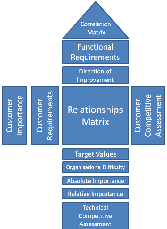Background of the 8D tool
The 8D problem solving tool forms the heart of any thorough problem solving process.
Developed from the engineering community the 8D problem solving tool
can be applied to any goods, services or processes that are experiencing
problems either during development or are currently in operation.
The 8D tool
The 8D tool
divides the problem solving process into sequential steps giving the
problem solving team structure to their work. Each step has its own
process and activities. This 8D tool has been recently improved with
an additional step added at the start of the process and an additional
replicate step added in recognition of the need to maximise the effects
of the work carried out. The process steps are:
- Identify
the need for a problem resolution
- Establish
the problem resolution team
- Describe
the problem
- Develop
containment
- Define
the root cause of the defined problem
- Develop
a permanent corrective action
- Validate
and implement the permanent corrective action
- Prevent
the problem from reoccurring
- Replicate
the solution
- Recognise
the team
Please note
that this training course details all ten steps whereas the traditional
8D retains only the original 8 steps.
Applications of the 8D tool
The 8D tool
can be used where any problems are encountered with any goods, services
or processes. Applications include problems in; design of consumer goods,
website development, restaurant front of house operations, manufacturing
process development, hotel services, software development etc. Essentially
the 8D problem solving tool should be applied in the the problem resolution
of problems encountered with any goods, services and processes. The
main point of the 8D tool is to establish the root cause of the problem
and give solutions that can be robustly applied. This minimises the
exposure of the problem to the customer and to the business, whether
the problem area is in development or currently in operation.
The 8D training course
This on-line
training course starts with an overview of the 8D problem solving tool
and the 8D process. The training course then guides the trainee through
a step by step process of how to conduct an 8D on goods, services and
processes. A worked example is given of an 8D applied to a production
process. This training course is given in English and is designed to
impart the capability to perform an 8D. This 8D problem solving training
course comes complete with a free download of the 8D template. No prior
knowledge is required or assumed and no special tools are needed.
Taking the 8D training course
Access to
this great on-line 8D problem solving training course is time limited
and not usage limited. Once payment or an order has been received we
will issue a user name and a keycode that gives unlimited user access
to the training course. This user name and keycode can be used as many
times as needed and by as many individuals as needed.
Another great web based training workshop from
Product Development Consultants

